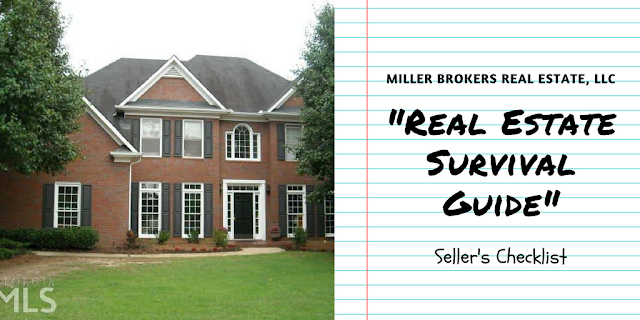Real Estate Survival Guide
1. Gauge your need to sell.
- Define your goals for the next 5-10 years.
- Weigh the pros and cons of selling your house.
- Figure out if you can afford to sell, move and buy a new home.
- Calculate your home equity.
- Research the local housing market.
- Consider remodeling the home to fit your needs.
- Weigh the pros and cons of renting out your home.
2. Calculate your selling expenses.
- List the repairs and projects you'll have to do to get your home in selling condition and estimate the costs of hiring supplies and contractors.
- See what projects you can afford and adjust how much you expect to get for selling your home.
- To get top dollar, consider remodeling projects and green upgrades that increase your home value.
- Expect to pay about 7 percent to 10 percent of the home's sale price in closing costs, including real estate agent commissions, transfer taxes and prorated property taxes.
And factor in these costs:
- Professional home inspection
- Capital gains tax
- Mortgage payoff penalties
- Staging and marketing expenses
- Moving expenses
- Cost of living in new city or neighborhood
- Costs related to getting a mortgage for new home
3. Contact a Real Estate Broker and Plan your selling strategy.
- Determine how fast you need to sell your house and how much money you want to get from the sale.
- Interview at least three reputable real estate brokers and list your home on the multiple listing service (MLS).
- Weigh the pros and cons of selling the home yourself.
- Learn how to go about selling your home yourself.
- Consider a physical or online auction for a quick sale in a slow market.
- Look into home-swapping opportunities online.
- Plan your sale during the spring or fall peak homebuying seasons.
- If you go FSBO (For Sale By Owner), hire a real estate agent or attorney.
- If you hire a listing agent, negotiate terms of your listing contract, such as commissions and termination date.
- Determine your home's strengths and unique features and promote them in all advertising.
4. Determine your home's fair market value (FMV) and set a price.
- Research public records and collect information on comps -- comparable homes in your area with similar square footage, construction, age and condition that sold within the past six months and are currently on the market.
- Browse listings for homes for sale in your area to get a sense of what is on the market and current home prices.
- Ask your agent to prepare a Comparative Market Analysis (CMA) report.
- Find out about new construction and foreclosures in your area.
- Figure out the average cost per square foot for your area, and make sure your home is in line with it.
- Evaluate market trends, including whether it's a buyer's or seller's market.
- Use your FMV to determine your asking price. Consider pricing strategies such as pricing low to urge a bidding war or Value Range Marketing.
5. Advertise and market the home.
- MLS listings
- "For Sale" signs
- Classified sections of local newspapers
- Real estate publications
- Put ads on free Web sites like craigslist.com.
- Create your own Web site to promote your home.
- Email notices or flyers about your home to real estate agents, friends, family, coworkers, everyone.
- Use photos to showcase your home. Hire a professional real estate photographer or learn how to take great pictures yourself.
- Use a handheld video camera to give online buyers a virtual tour of your home, by walking through each room and talking about its features.
6. Prepare and stage the home.
- Have a yard sale. Sell, donate or trash everything you don't need.
- Make necessary repairs.
- Make improvements to increase your curb appeal, i.e. the home's external attractiveness when viewed from the street.
- Hire a professional home stager or research staging tips.
- Declutter, depersonalize and decorate every room and outdoor areas so buyers can imagine themselves living in the home.
- Paint interior rooms neutral colors.
- Replace outdated lighting fixtures and window treatments.
7. Set up showings and open houses.
- Keep the home in show-ready condition at all times.
- Take appointments or set up a lockbox so agents can show the home when you're not available.
- Hold an exclusive open house for local real estate agents to introduce them to the home and get feedback. Include food and refreshments.
- Hold an open house for potential buyers. Advertise in local publications and put up signage in the area.
8. Review purchase offers.
- For each offer, note the proposed offer price, preapproval letter, contingencies, earnest money amount, proposed closing date and offer expiry date.
- Have a process in place if you expect to get multiple offers.
- Keep emotions in check when receiving lowball offers.
9. Make counteroffers and negotiate.
- Approach each offer as an opportunity to negotiate.
- If the buyer's offer is contingent on selling a home, counter with a Removal of Sale Contingency.
- If you won't budge on price, offer financial incentives that don’t require cash out of your pocket, such as paying for part or all of the buyer's closing costs, repairs found during the property inspections or points.
- Offer to include furniture, appliances, window treatments or lighting fixtures.
- If you're worried you won't be able to buy a home after you sell, include a "rent back" clause which lets you rent back your home from the buyers after escrow closes.
- Make a full-price counteroffer, if your comps can back it up.
- Make the sale contingent on your buying a home.
- Don't forget to set a closing date and move-in date.
- If you find a serious buyer who is having trouble qualifying for a mortgage, consider offering seller financing, a mortgage assumption or a lease-to-own deal.
10. Get through escrow.
- Create a formal plan for handling home repairs, including when they should be made and who pays for them.
- Clean and prepare the home for the appraisal and home inspections.
- Choose an escrow officer who will order a title search, request payoff information for your mortgage and other liens on the home, prepare and record documents, hold and disburse funds and prepare closing statements.
- Prepare for the final walk-through inspection.
- Sign the closing documents and move out of your home.
- Keep copies of your documents for reporting the sale on federal and state tax forms.



Comments
Post a Comment